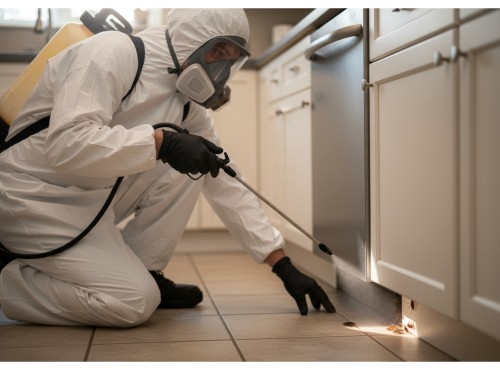Ant Management Across Residential Zones
Ant infestations, particularly pavement and carpenter ants, are prevalent in suburban areas from Scarborough to Etobicoke. Colonies tend to establish near structural foundations, driveways, and gardens, taking advantage of damp wood and decaying vegetation.
Technicians typically apply residual barrier sprays or baiting systems around exterior perimeters and entry points. Carpenter ant treatments may require void injections using foam or dust formulations to reach internal galleries.
Average costs in Toronto for ant management range between CAD $150–$300, with higher fees for large colonies inside wall voids. Preventive maintenance, including moisture control and vegetation trimming, remains an integral component of sustainable management programs.
Homeowners near The Beaches often request annual inspections before summer months to preempt colony expansion, especially after damp springs. This proactive approach aligns with CPMA recommendations for early detection and prevention.
Termites and Structural Protection
Termites, though less visible, pose substantial risk to wooden structures in Toronto’s older residential sectors. Subterranean colonies exploit small cracks in concrete slabs or foundation walls, forming extensive subterranean galleries.
PMPs employ baiting systems, trenching, and drill-and-treat procedures to deliver targeted termiticides into soil or wood contact points. Products used must possess valid PCP registration numbers and clear re-entry guidance to comply with Health Canada regulations.
Treatment costs generally span CAD $500–$1,500 for smaller infestations, increasing with structural complexity. Technicians frequently supplement chemical barriers with moisture reduction and foundation repairs, reducing conducive conditions that attract termite activity.
Wildlife and Seasonal Pests
Wildlife management occupies a growing segment of Toronto’s pest control industry. Raccoons, squirrels, and bats routinely infiltrate attics, rooflines, and soffit gaps across neighbourhoods from High Park to East York. Ethical handling under Ministry of Natural Resources and Forestry (MNRF) guidance requires humane trapping, exclusion, and post-removal sanitation.
Seasonal pests such as wasps, hornets, and cluster flies add additional cost variance, with complex structural extractions occasionally exceeding several thousand dollars. PMPs conduct void treatments, nest removals, and exclusion sealing to prevent re-entry.
Service records indicate that most wildlife jobs fall between CAD $300–$1,000, although attic restoration after raccoon damage can surpass CAD $5,000 due to insulation replacement and decontamination.
Integrated Solutions for a Dynamic City
The city’s pest challenges mirror its architectural and climatic diversity. Providers offering comprehensive maintenance programs benefit from predictable scheduling, stronger client relationships, and consistent revenue streams. For tenants and property owners, this means preventive assurance and minimized infestation recurrence.
When evaluating long-term solutions, professional firms that emphasize monitoring, habitat modification, and client education deliver not just immediate relief but measurable stability within Toronto’s urban pest ecosystem. Their combined commitment to regulation, safety, and ecological mindfulness defines the present standard for insect control services, a market where compliance, transparency, and technical precision determine credibility and success.
Compliance Success in a Downtown Complex
A 2024 compliance audit conducted in a condominium complex near Jarvis and Dundas Streets illustrates the value of structured documentation. The property had experienced persistent German cockroach activity despite multiple contractor interventions. When a new PMP team implemented a WHMIS-compliant logbook system and weekly monitoring schedule, the infestation was traced to neglected garbage-chute voids between floors.
By introducing pheromone traps, performing sanitation reviews, and sealing utility penetrations, the technicians achieved complete control within six weeks. The building subsequently passed its municipal health inspection with no violations. This outcome underscored the principle that regulatory discipline, combined with correct diagnostics, directly improves service success and tenant satisfaction.
Safety, Ethics, and the Role of Documentation
Every reputable PMP recognizes that effective pest control is as much about risk management as pest elimination. Chemical sensitivity warnings, re-entry timing, and environmental precautions must be communicated to clients in advance.
Toronto’s leading firms increasingly integrate digital documentation tools that track treatments, monitor pest pressure trends, and store chemical usage data for auditing. These tools support compliance with Restricted Entry Interval (REI) guidelines and help property managers demonstrate adherence during Health Canada or local health-unit inspections.
Documentation also fulfills an ethical function. Clear records protect both the provider and the occupant, ensuring transparency in cases involving pesticide sensitivity or disputes regarding efficacy.
Building a Sustainable Future for Pest Management in Toronto
Toronto’s pest management industry continues to mature into a model of environmental stewardship and technical discipline. As the city expands vertically and demographically, pest control companies will need to integrate smart monitoring devices, data analytics, and eco-safe formulations to maintain efficiency and compliance.
Advancements such as sensor-equipped bait stations, digital trend analysis, and remote surveillance platforms already allow real-time activity tracking without intrusive inspections. These innovations reduce pesticide dependency and support predictive maintenance scheduling for property managers across the GTA.
At its core, the profession remains grounded in ethics and community protection. Every technician certified under Health Canada and the MECP represents a safeguard for Toronto’s residents and environment.









